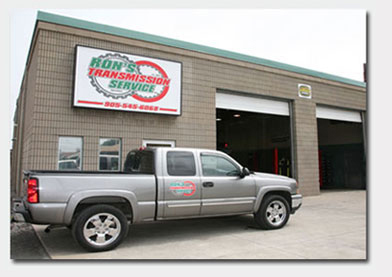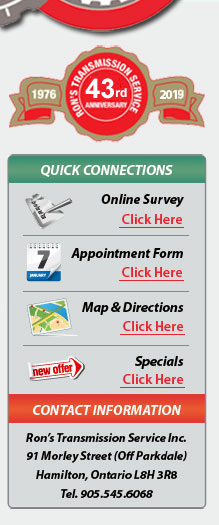|
One-Way
Clutch A one-way clutch (also known as a "sprag" clutch) is a
device that will allow a component such as ring gear to turn freely in
one direction but not in the other. This effect is just like
that of a bicycle, where the pedals will turn the wheel when pedaling
forward, but will spin free when pedaling backward.
A common place where a one-way clutch is used is in first gear when
the shifter is in the drive position. When you begin to accelerate from
a stop, the transmission starts out in first gear. But
have you ever noticed what happens if you release the gas while it is
still in first gear? The vehicle continues to coast as if you were
in neutral. Now, shift into Low gear
instead of Drive. When you let go of the gas in this case, you
will feel the engine slow you down just like a standard shift car. The
reason for this is that in Drive, a one-way clutch is used whereas in
Low, a clutch pack or a band is used.
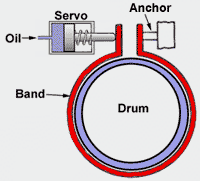 Bands Bands
A band is a steel
strap with friction material bonded to the inside surface. One end
of the band is anchored against the transmission case while the other
end is connected to a servo. At the appropriate time hydraulic oil
is sent to the servo under pressure to tighten the band around the drum
to stop the drum from turning.
Torque
Converter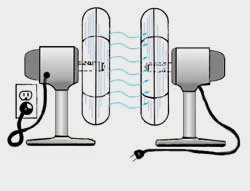
On automatic transmissions, the torque converter takes the place of the clutch found on
standard shift vehicles. It is there to allow the engine to
continue running when the vehicle comes to a stop. The
principle behind a torque converter is like taking a fan that is
plugged into the wall and blowing air into another fan which is
unplugged. If you grab the blade on the unplugged fan, you are able to hold
it from turning but
as soon as you let go, it will begin to speed up until it comes close to
the speed of the powered fan. The difference with a torque
converter is that instead of using air, it uses oil or transmission
fluid, to be more precise.
A torque converter is a large doughnut shaped device (10" to
15" in diameter) that is mounted between the engine and the
transmission. It consists of three internal elements that work
together to transmit power to the transmission.
The
three elements of the torque converter are the Pump, the 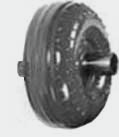 Turbine,
and the Stator. The pump is mounted directly to the converter
housing which in turn is bolted directly to the engine's crankshaft and
turns at engine speed. The turbine is inside the housing and is
connected directly to the input shaft of the transmission
providing power to move the vehicle. The stator is mounted to Turbine,
and the Stator. The pump is mounted directly to the converter
housing which in turn is bolted directly to the engine's crankshaft and
turns at engine speed. The turbine is inside the housing and is
connected directly to the input shaft of the transmission
providing power to move the vehicle. The stator is mounted to 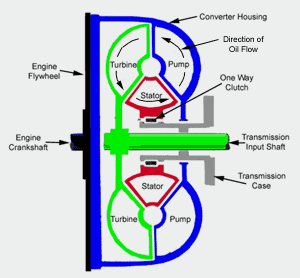 a
one-way clutch so that it can spin freely in one direction but not in
the other. Each of the three elements have fins mounted in them to
precisely direct the flow of oil through the converter a
one-way clutch so that it can spin freely in one direction but not in
the other. Each of the three elements have fins mounted in them to
precisely direct the flow of oil through the converter
With the engine running, transmission fluid is pulled into the
pump section and is pushed outward by centrifugal force until it reaches
the turbine section which starts it turning. The fluid continues
in a circular motion back towards the center of the turbine where it
enters the stator. If the turbine is moving considerably slower than the
pump, the fluid will make contact with the front of the stator fins
which push the stator into the one way clutch and prevent it from
turning. With the stator stopped, the fluid is directed by the stator
fins to re-enter the pump at a "helping" angle providing a
torque increase. As the speed of the turbine catches up with
the pump, the fluid starts hitting the stator blades on the back-side
causing the stator to turn in the same direction as the pump and
turbine. As the speed increases, all three elements begin to turn
at approximately the same speed.
Since the '80s, in order to improve fuel economy, torque converters
have been equipped with a lockup clutch (not shown) which locks the
turbine to the pump as the vehicle speed reaches approximately 45 - 50
MPH. This lockup is controlled by computer and usually won't
engage unless the transmission is in 3rd or 4th gear.
Hydraulic
System
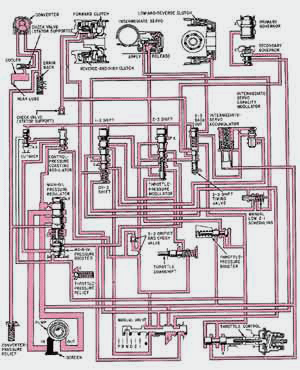 The
Hydraulic system is a complex maze of passages and tubes that sends
transmission fluid under pressure to all parts of the transmission and
torque converter. The diagram at left is a simple one from a
3-speed automatic from the '60s. The newer systems are much more
complex and are combined with computerized electrical components. Transmission fluid serves a number of purposes
including: shift control, general lubrication and transmission
cooling. Unlike the engine, which uses oil primarily for
lubrication, every aspect of a transmission's functions are dependant on
a constant supply of fluid under pressure. This is not unlike the
human circulatory system (the fluid is even red) where even a few
minutes of operation when there is a lack of pressure can be harmful or
even fatal to the life of the transmission. In order
to keep the transmission at normal operating temperature, a portion of
the fluid is sent through one of two steel tubes to a special chamber
that is submerged in anti-freeze in the radiator. Fluid passing
through this chamber is cooled and then returned to the transmission
through the other steel tube. A typical transmission has an
average of ten quarts of fluid between the transmission, torque
converter, and cooler tank. In fact, most of the components of a
transmission are constantly submerged in fluid including the clutch
packs and bands. The friction surfaces on these parts are designed
to operate properly only when they are submerged in oil. The
Hydraulic system is a complex maze of passages and tubes that sends
transmission fluid under pressure to all parts of the transmission and
torque converter. The diagram at left is a simple one from a
3-speed automatic from the '60s. The newer systems are much more
complex and are combined with computerized electrical components. Transmission fluid serves a number of purposes
including: shift control, general lubrication and transmission
cooling. Unlike the engine, which uses oil primarily for
lubrication, every aspect of a transmission's functions are dependant on
a constant supply of fluid under pressure. This is not unlike the
human circulatory system (the fluid is even red) where even a few
minutes of operation when there is a lack of pressure can be harmful or
even fatal to the life of the transmission. In order
to keep the transmission at normal operating temperature, a portion of
the fluid is sent through one of two steel tubes to a special chamber
that is submerged in anti-freeze in the radiator. Fluid passing
through this chamber is cooled and then returned to the transmission
through the other steel tube. A typical transmission has an
average of ten quarts of fluid between the transmission, torque
converter, and cooler tank. In fact, most of the components of a
transmission are constantly submerged in fluid including the clutch
packs and bands. The friction surfaces on these parts are designed
to operate properly only when they are submerged in oil.
Oil
Pump
The transmission
oil pump (not to be confused with the pump element inside the
torque converter) is responsible for producing all the oil pressure that
is required in the transmission. The oil pump is mounted to the
front of the transmission case and is directly connected to a flange on
the torque converter housing. Since the torque converter housing
is directly connected to the engine crankshaft, the pump will produce
pressure whenever the engine is running as long as there is a sufficient
amount of transmission fluid available. The oil enters the pump through
a filter that is located at the bottom of the transmission oil pan and
travels up a pickup tube directly to the oil pump. The oil is then sent,
under pressure to the pressure regulator, the valve body and the rest of
the components, as required.
Valve
Body
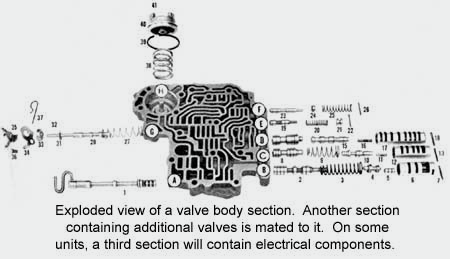 The
valve body is the control center of the automatic transmission. It
contains a maze of channels and passages that direct hydraulic fluid to
the numerous valves which then activate the appropriate clutch pack or
band servo to smoothly shift to the appropriate gear for each driving
situation. Each of the many valves in the valve body has a
specific purpose and is named for that function. For example the 2-3
shift valve activates the 2nd gear to 3rd gear up-shift or the 3-2 shift
timing valve which determines when a downshift should occur. The
valve body is the control center of the automatic transmission. It
contains a maze of channels and passages that direct hydraulic fluid to
the numerous valves which then activate the appropriate clutch pack or
band servo to smoothly shift to the appropriate gear for each driving
situation. Each of the many valves in the valve body has a
specific purpose and is named for that function. For example the 2-3
shift valve activates the 2nd gear to 3rd gear up-shift or the 3-2 shift
timing valve which determines when a downshift should occur.
The most important valve, and the one that you have direct control over
is the manual valve. The manual valve is directly connected to the
gear shift handle and covers and uncovers various passages depending on
what position the gear shift is placed in. When you place the gear
shift in Drive, for instance, the manual valve directs fluid to the
clutch pack(s) that activates 1st gear. it also sets up to monitor
vehicle speed and throttle position so that it can determine the optimal
time and the force for the 1 - 2 shift. On computer controlled
transmissions, you will also have electrical solenoids that are mounted
in the valve body to direct fluid to the appropriate clutch packs
or bands under computer control to more precisely control shift points.
Computer
Controls
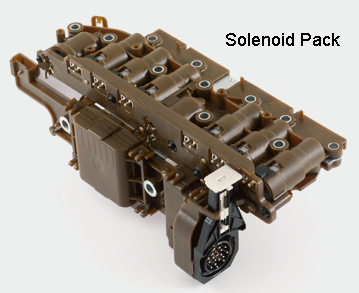 The computer uses sensors on the engine and transmission to detect such
things as throttle position, vehicle speed, engine speed, engine load,
brake pedal
position, etc. to control exact shift points as well as how soft or firm
the shift should be. Once the computer receives this information,
it then sends signals to a solenoid pack inside the transmission.
The solenoid pack contains several electrically controlled solenoids
that redirect the fluid to the appropriate clutch pack or servo in order
to control shifting. Computerized transmissions even learn
your driving style and constantly adapt to it so that every shift is
timed precisely when you would need it. The computer uses sensors on the engine and transmission to detect such
things as throttle position, vehicle speed, engine speed, engine load,
brake pedal
position, etc. to control exact shift points as well as how soft or firm
the shift should be. Once the computer receives this information,
it then sends signals to a solenoid pack inside the transmission.
The solenoid pack contains several electrically controlled solenoids
that redirect the fluid to the appropriate clutch pack or servo in order
to control shifting. Computerized transmissions even learn
your driving style and constantly adapt to it so that every shift is
timed precisely when you would need it.
Because of computer controls, sports models are coming out with the
ability to take manual control of the transmission as though it were a
stick shift, allowing the driver to select gears manually. This is
accomplished on some cars by passing the shift lever through a special
gate, then tapping it in one direction or the other in order to up-shift
or down-shift at will. The computer monitors this activity to make
sure that the driver does not select a gear that could over speed the
engine and damage it.
Another advantage to these "smart" transmissions is that they have a
self diagnostic mode which can detect a problem early on and warn you
with an indicator light on the dash. A technician can then plug
test equipment in and retrieve a list of trouble codes that will help
pinpoint where the problem is.
Governor,
Vacuum Modulator, Throttle
Cable
These three components are important in the non-computerized
transmissions. They provide the inputs that tell the transmission when
to shift. The Governor is connected to the output shaft and regulates hydraulic pressure based
on vehicle speed. It accomplishes this using centrifugal force to spin a
pair of hinged weights against pull-back springs. As the weights
pull further out against the springs, more oil pressure is allowed past
the governor to act on the shift valves that are in the valve body which
then signal the appropriate shifts.
Of course, vehicle speed is not the only thing that controls when a
transmission should shift, the load that the engine is under is also
important. The more load you place on the engine, the longer the
transmission will hold a gear before shifting to the next one.
There are two types of devices that serve the purpose of monitoring
the engine load: the Throttle
Cable and the Vacuum
Modulator. A
transmission will use one or the other but generally not both of these
devices.
Each works in a different way to monitor engine load.
The Throttle Cable
simply monitors the position of the gas pedal through a cable that runs from
the gas pedal to the throttle valve in the valve body.
The Vacuum Modulator monitors engine vacuum by a rubber vacuum hose
which is connected to the engine. Engine vacuum reacts very
accurately to engine load with high vacuum produced when the engine is
under light load and diminishing down to zero vacuum when the engine is
under a heavy load. The modulator is attached to the outside of
the transmission case and has a shaft which passes through the case and
attaches to the throttle valve in the valve body. When an engine
is under a light load or no load, high vacuum acts on the modulator
which moves the throttle valve in one direction to allow the
transmission to shift early and soft. As the engine load
increases, vacuum is diminished which moves the valve in the other
direction causing the transmission to shift later and more firmly.
Seals
and Gaskets
An automatic transmission has many seals and
gaskets to control the flow of hydraulic fluid and to keep it from
leaking out. There are two main external seals: the front seal and
the rear seal. The front seal seals the point where the torque converter
mounts to the transmission case. This seal allows fluid to freely move
from the converter to the transmission but keeps the fluid from leaking
out. The rear seal keeps fluid from leaking past the output shaft.
A seal is usually made of rubber (similar to the rubber in a
windshield wiper blade) and is used to keep oil from leaking past a moving
part such as a spinning shaft. In some cases, the rubber is assisted by
a spring that holds the rubber in close contact with the spinning
shaft.
A gasket is a type of seal used to seal two stationary parts that are
fastened together. Some common gasket materials are: paper, cork,
rubber, silicone and soft metal.
Aside from the main seals, there are also a number of other seals and
gaskets that vary from transmission to transmission. A common example is
the rubber O-ring that seals the shaft for the shift control
lever. This is the shaft that you move when you manipulate the
gear shifter. Another example that is common to most transmissions
is the oil pan gasket. In fact, seals are required anywhere that a
device needs to pass through the transmission case with each one being a
potential source for leaks.
|

